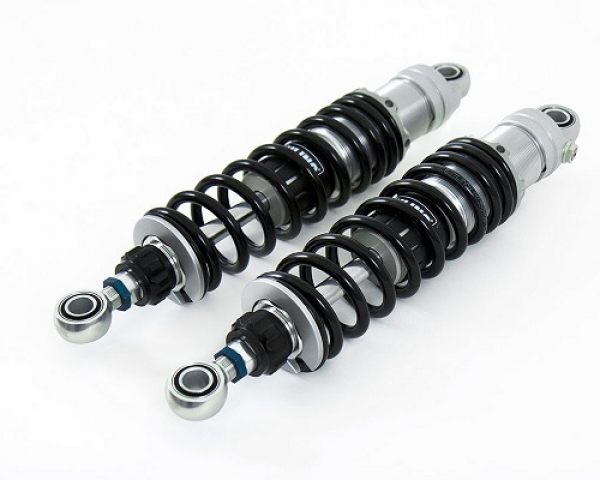
Know Your Shocks
1) What do Shock Absorbers do?
Contrary to popular belief, shocks don’t support your vehicle’s weight or help carry the load. That is the job of the springs. The springs hold the vehicle up, and the shocks push the tyres down, keeping them in contact with the road. If at any stage one or more of those four small patches of tyre the size of your hand lose contact with the road, you lose control of your vehicle.
Drive down a straight, well surfaced road for 1km – your shocks just made between 500 & 1000 movements up or down. Now imagine all the bumps, potholes, side winds, swerves, turns and sudden stops that you encounter daily – your shock absorbers are working hard to keep your vehicle safely on the road.
2) How long do shock absorbers last?
Of course this depends on the type of roads you drive, and checks are important. Reputable shock manufacturers such as Gabriel estimate the average life of a shock in a passenger vehicle to be about 80 000km. By then the shock has made up to 80 million movements and will definitely no longer be functioning the way it did when it was new… slow shock response results in diminishing steering control and stopping distance, and results in faster & irregular tyre wear and even brake wear, increasing your maintenance costs. In fact all your suspension parts are under increased stress and strain, and your vehicle is no longer safe on the road.
3) How do I know if my shocks need replacement?
The age old test is to press down heavily on each corner of your car. (We call this “the bounce test”) If it makes more than 3 movements up and down after releasing, your shocks need replacement. This test has its flaws – the shock may be ceasing up and there will be hardly any movement at all… Unfortunately shocks deteriate slowly, and as a driver of the vehicle one may not notice the extra roll or bounce over time. Immediately after replacing these worn shocks the difference will be obvious!
Gabriel lists 8 tell-tale signs that indicate shock wear:
A) The steering wheel vibrates
B) The car nose dives when braking
C) Excessive bounce on rough surfaces
D) Bald patches on the tyres
E) The car veers in side winds
F) The car does not hug the road on bends
G) Oil is leaking from the shocks
H) Shocks are dented or damaged
One could of course remove the shocks to perform a manual check, however this is quite a lengthy (and therefore expensive) process. Bear in mind, the shock absorber consists of up to 40 engineered parts including valves, pistons, rubbers & seals – any of these can fail at any time. At auto1 we are equipped with the best state of the art computerized testing machinery available to accurately measure the response of the shocks – naturally our experienced technicians also check for all the above tell-tale signs to ensure your safety and comfort. While the computer can measure how well the shock is functioning today, it cannot check for leaks, damage, or irregular tyre wear, and this is why we also heavily rely on the eyes and hands of our well-trained auto1 team. Shock/strut mountings could also need replacement – as a general rule we recommend these tests and checks at least every 30 000km or every second service.
4) Gas shocks versus oil shocks
Gas shocks are actually 95% filled with oil – the 5% gas content is nitrogen gas filled and basically ensures a faster reaction time. Many newer model passenger cars are factory fitted with gas shocks to keep up with this technology. At auto1 we try to replace parts with the equivalent product that was factory fitted, or an upgrade when the vehicle outdates available technology. Your safety is our top priority.
Don’t be fooled! Many vehicles, especially bakkies are actually still factory fitted with oil shocks. There are companies that purchase the same oil shock, cover it with a bigger housing, spray it with a bright colour and label it as a super duper off-road shock that comes with a huge price tag…. at auto1 we do not recommend these so-called “upgrades” – the standard oil shock may look skinny and unimpressive in comparison, but it is built for the vehicle, is tough, and economical. (Just not as sexy perhaps – no crazy paint job, animal stickers, and rebranding
5) My boot/hood/canopy door/trailer lid doesn’t stay open anymore
Over time the little gas filled shock that keeps your boot/hood/canopy door or trailer lid open will start leaking and not work as effectively as it used to. After it has unexpectedly closed and hit you on the back of the head a number of times you will improvise with a sawed off piece of broomstick to keep it open. At auto1 we carry a full range of replacement Gabriel Gaslifts, and universal Gaslifts to replace these. Sometimes it is possible to immediately re-gas the shock you have. This regas is often cheaper than the price of the broom you destroyed to remedy the situation!
6) What is the difference between a strut and a shock?
Both do the same thing. A shock can never be replaced with a strut, and a strut can never be replaced with a shock. Your vehicle is fitted with one or the other, or one on the front, the other on the rear. The main difference is the spring perch incorporated on the strut that holds the vehicles spring. Some struts are a one piece unit, while others can be replaced with a strut insert, saving the cost of the entire strut housing.
7) Can I replace one shock at a time?
The short answer is no. Shocks should be replaced in pairs. (front and/or rear) They work together – would you buy one shoe at a time?
